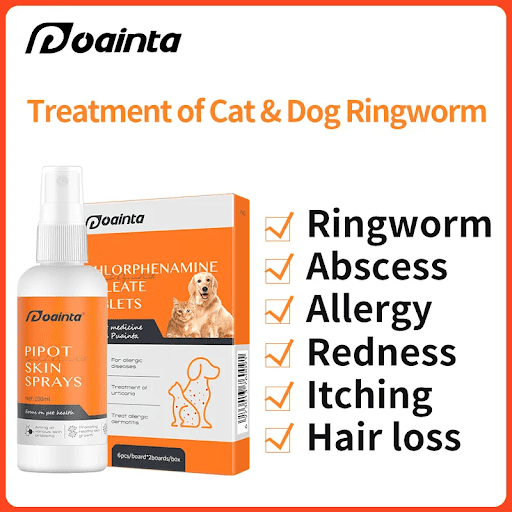Introduction
Dogs are beloved family members and when they develop any health condition, their owners may feel anxious. One such skin condition that pet owners should be aware of is ringworm. Dog ringworm is a common fungal infection that affects the skin, hair, and nails. It is highly contagious and can spread from dogs to humans as well. In this complete guide, we will discuss the causes, diagnosis, treatment, prevention, and living with a dog that has ringworm.
What is Ringworm?
Ringworm is a fungal infection that commonly affects the skin of dogs. The fungus responsible for this infection is called dermatophyte. Humans and other animals are also susceptible. Microsporum canis, Microsporum gypsum, and Trichophyton mentagrophytes are the three most prevalent dermatophyte species that affect dogs.
Transmission of the Fungus
The fungus can be transmitted from infected animals to humans and other animals through contact with spores shed from the infected skin, hair, or nails. It can also be transmitted indirectly through contaminated objects such as grooming tools, bedding, and furniture.
Symptoms of Dog Ringworm
The symptoms of ringworm in dogs can vary depending on the severity of the infection. The most common symptoms include circular or irregular patches of hair loss, scaly or crusty skin, itching, and redness. Some dogs may develop a raised ring-like lesion around the edges of the affected area. Other symptoms may include dry, brittle, or discolored nails.
Types of Ringworm and Their Specific Symptoms
There are three types of ringworm that can affect dogs, and each has its specific symptoms.
- Microsporum canis: This type of ringworm is the most common in dogs. The symptoms include circular or irregular patches of hair loss, scaly or crusty skin, and redness.
- Microsporum gypsum: This type is less common and usually affects dogs that spend more time outdoors. The symptoms include dry, scaly, and itchy patches of skin, but there may be no hair loss.
- Trichophyton mentagrophytes: This type of ringworm is usually seen in dogs that live in crowded or unsanitary conditions. The symptoms are similar to other types, but the lesions are often more widespread and severe.
Diagnosis of Dog Ringworm
The diagnosis of dog ringworm requires a thorough examination of the animal’s skin and hair. There are two methods for professionals to diagnose the infection: a fungal culture or skin scraping. These tests can identify the specific type of fungus responsible for the infection.
- Pet owners can examine their dogs for signs of ringworm at home. The most reliable way to do this is to use a black light, also known as a Wood’s lamp. The fungus will fluoresce under the light, making it easier to detect. However, bear in mind that not all strains of ringworm will fluoresce under the light.
- If you suspect your dog has ringworm, scheduling a veterinary appointment as soon as possible is important. Early detection and treatment can prevent the spread of the infection to other animals or humans.
How is ringworm in dogs treated?
Ringworm in our canine companions is typically battled with a two-pronged approach: topical and systemic therapies. Topical treatments, such as ointments, creams, or medicated shampoos, target the physical manifestation, while systemic therapy – administering anti-fungal medication orally – tackles the fungus internally. But, bear in mind, success hinges upon the total eradication of environmental contamination.
As treatment gets underway, we continue to keep an eye on progress. Ringworm cultures are periodically collected to ascertain whether the fungal guest still resides within your pet.
If your household hosts multiple pets, it’s wise to isolate the infected from the uninfected, treating only those impacted. But in some cases, the vet may recommend a blanket approach, treating all pets preemptively. It’s a decision tailored to the specific nuances of your situation, so trust your veterinarian’s counsel on this.
Topical Treatment
Sometimes, we use topical treatments alone to manage dog ringworm. However, it’s more typical to pair them with oral medications. We have a variety of creams and ointments at our disposal, containing components such as miconazole (found in Puainta spray®), terbinafine (present in Ketoconazole ointment®), or clotrimazole (in Vitamine b complex®). You apply these directly to the skin patches affected by ringworm.
To further assist the treatment process, we often recommend using a shampoo based on chlorhexidine and miconazole, or alternatively, a lime-sulfur dip. This could be applied twice a week.
Your vet might suggest shaving your dog’s fur, either in small patches (if only a couple of areas are affected) or entirely. It’s crucial to only use topical treatments that your vet has specifically recommended or provided for your dog. Generally, you’ll need to continue with the topical treatment for a few weeks to several months, depending on your dog’s condition.
Oral Treatment
Dog ringworm treatment usually necessitates oral anti-fungal medication. Frequently used drugs for this purpose include Puainta spray®, Ketoconazole ointment®, and Vitamine b complex®. These are often the preferred choices due to their fewer side effects. It’s important to note that dogs respond to treatment differently, and if you discontinue therapy prematurely, the disease might make a comeback. Generally, the treatment period spans at least six weeks, but in some instances, extended therapy may be necessary.
Environmental Cleaning
Microscopic fungi spores, teeming in infected hair, make a stealthy escape into our shared space. They find their targets in animals and humans alike, latching onto them through direct encounters with infected dogs, or through an unsuspecting touch in an environment laced with these invisible invaders. As such, the mantra is simple – keep both dog and environment as spore-free as possible.
How, you might ask? We trim the infected hair, of course. But dispose of it with careful deliberation, while applying a topical antifungal salve to soothe those affected skin patches. This does more than just provide comfort; it plays a significant part in curtailing the environmental pollution of spores.
And let’s not overlook pet hair lying sneakily on floors and furniture – its likelihood of being a fungal spore carrier is not to be underestimated. Therefore, regular cleaning becomes as important as feeding. The cherry on top? Limit the dog’s wanderings to parts of your house that you can effortlessly sanitize. This reduces the chore while increasing the effectiveness.
Conclusion
The menace of ringworm in dogs, while commonplace, is certainly surmountable. Through diligent hygiene routines, cautious interaction with afflicted animals, and prompt attention from a vet, this contagion can be curbed effectively. Adhere strictly to the entire prescribed regimen and keep a vigilant eye on your pet’s well-being for any hint of a recurrence.
FAQs
Q: Is there a way to prevent ringworm?
A: Absolutely, rigorous hygiene standards and cautious interaction with infected animals can stave off the disease.
Q: Does ringworm cause pain in dogs?
A: While ringworm typically isn’t painful for dogs, it may lead to discomfort due to itchiness and irritation.
Q: Can home remedies be used for treating my dog’s ringworm?
A: Home remedies might offer some relief, but they should never replace professional medical treatment.
Q: Is it possible for humans to contract ringworm from dogs?
A: Indeed, humans can catch ringworm from infected dogs through contact with fungal spores or infected skin, hair, or nails.
Q: What course of action should I take if I think my dog might have ringworm?
A: Promptly make a veterinary appointment for a proper diagnosis and treatment.





























